Ropeways
First Segment: Pontal d’Entrèves – Mont Frety
The new cableway line connects the area known as Pontal d’Entrèves, at an altitude of 1308 metres, with the Mont Frety area, at an altitude of 2172 meters above sea level.
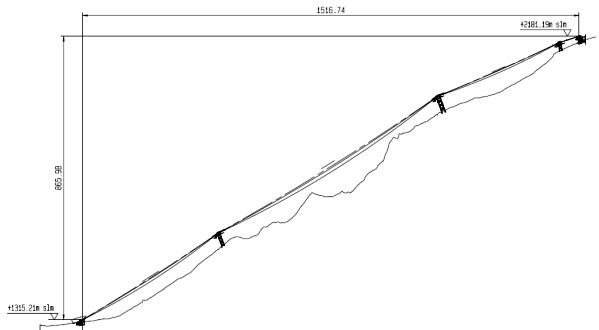
The departure station is approximately 700 meters from the old station below, and is located near the national road that leads up to the Mont Blanc tunnel. The upper station, instead, is about 30 metres to the left if looking up towards the station from the valley.
The new system is designed for fully rotating cable cars that can carry up to 80 +1 passengers. The system’s rated speed is a constant 9.0 m/s. This speed allows a maximum carrying capacity of 800 persons/hour, taking into account a 100 second dwell time.
The track requires constructing three line supports, located: the first, approximately 490 meters from the valley station; the second, located approximately 790 metres from the first support; and the third, located 63 metres from the upper station.
The facilities are to use the classic twin-cable two-car bi-directional cableway system, with the motor located in the lower station and the drive referral and counterweight located in the upper station. It is the dual suspension cable type, with ropes anchored at both stations on reinforced concrete drums faced with wooden slats, and hauling cables suspended between them using line bolts. The main traction ring, with counterweight on the lower section, consists of two half rings. The lower and upper hauling cables are connected to each car with a traction grip connection consisting of a drum around which the cables wrap themselves for 2.5 spins using clamps.
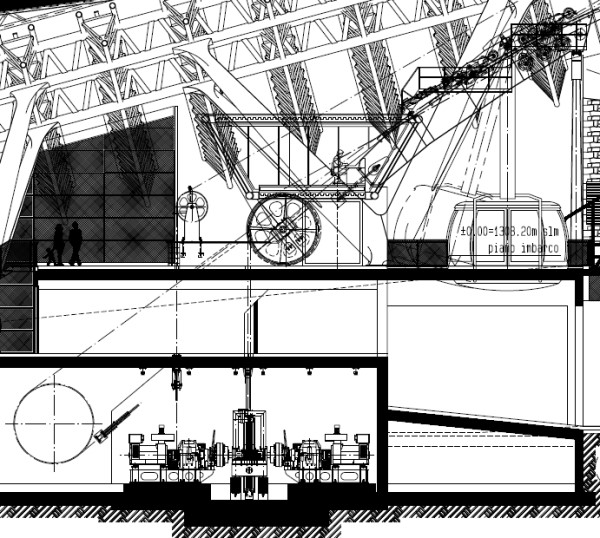
The main and reserve drives use a double grooved drive pulley activated by two winches and by a counter-pulley that sends the cable back to the motor pulley. Each winch consists of a reducer and an AC motor powered by its own inverter, each serving as backup to the other.
The drives are equipped with devices for automatic gear motion, using Funitek programmable logic, which allows operating the cable cars even without the presence of a machinist at the control panel.
The winch is equipped with two independent modulated pneumatic braking systems, both acting directly on the motor pulley’s crown, having two independent brake bands. Each winch will also have independent recovery activation, allowing cable cars to return to the station in the event of malfunction.
The recovery drive acting on the fast shafts of the reducers, uses hydraulic motors (one for each reducer) powered by a control unit with hydraulic distribution. The latter consists of variable capacity twin parallel pumps driven by a three-stroke asynchronous electric motor. If one of the two electric motors fails, the system can be operated using the other winch; in case one of the two reducers malfunctions, the hydraulic motor applied to the operating reducer can be activated, thus reeling the cable cars back into the station. The system thus has a double security system for maximum reliability.
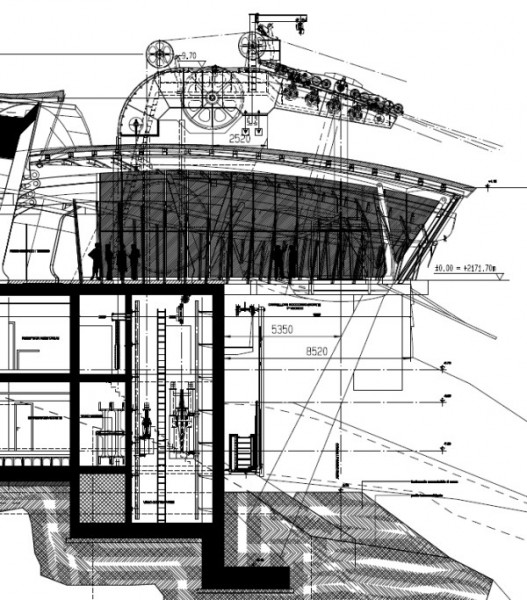
As an additional security on the system, in the extremely unlikely event of being unable to return the cars to the station within a reasonable amount of time, there will be two rescue systems: an “aerial” one that allows transferring passengers from the malfunctioning car to the rescue car, and the other allows lowering passengers to the ground using a “hammock”.
The aerial rescue system consists of special vehicles that move along the cables. They are moved by a special rescue cable ring spliced with its own winch that works independently from the main system, and which is located at the lower motor station and counterweighted at the upper station on two segments. The plant has a total of two rescue vehicles, one of which is located at the lower motor station and one at the drive recovery station. For the first time, even the rescue winch is double, with two engines.
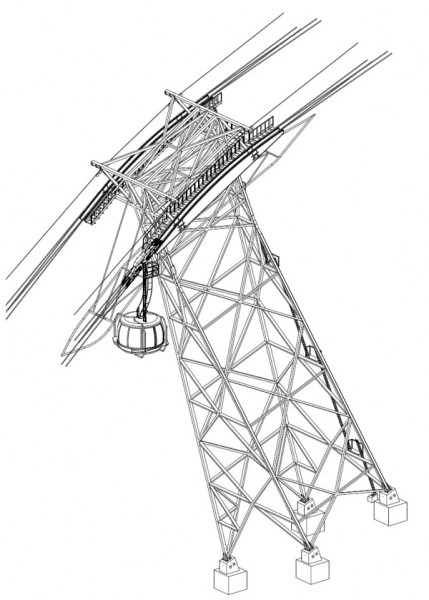
Second Segment: Mont Frety – Pointe Helbronner
The new cableway line connects the Mont Frety area (2176 m above sea level) with Pointe Helbronner (3449 metres a.s.l.).
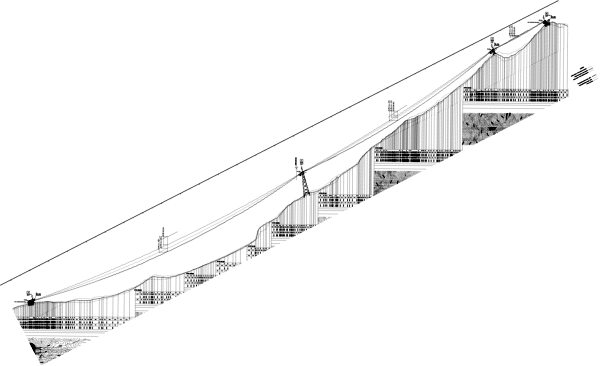
The departure station is approximately 30 metres from the current lower station. The upper station, instead, due to the restricted space, is going to be located exactly where the current station is.
The new system is designed for fully rotating cable cars that can carry up to 75 +1 passengers. The system’s rated speed is a constant 9.0 m/s. This speed allows a maximum carrying capacity of 610 persons/hour, taking into account a 90 second dwell time.
The track requires constructing two line supports, located: the first, approximately 1870 meters from the lower station; the second, located approximately 268 metres from the upper station.
The facilities are to use the classic twin-cable two-car bi-directional cableway system, with the motor located in the lower station and the drive referral and counterweight located in the upper station. It is the dual suspension cable type, with ropes anchored at both stations on reinforced concrete drums faced with wooden slats, and hauling cables suspended between them using line bolts. The main traction ring, with counterweight on the lower section, consists of two half rings. The lower and upper hauling cables are connected to each car with a traction grip connection consisting of a drum around which the cables wrap themselves for 2.5 spins using clamps.
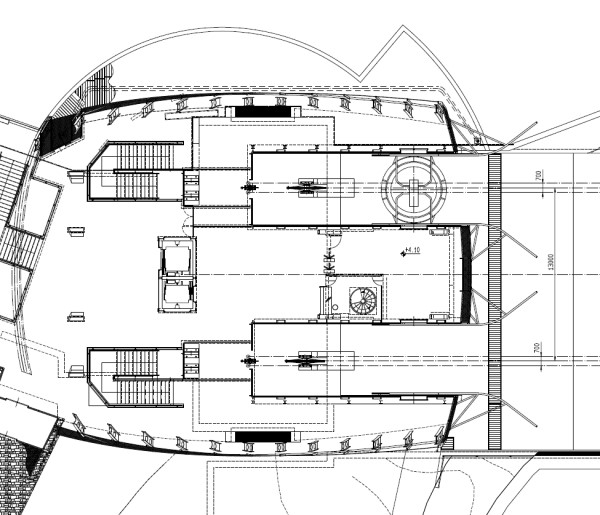
The main and reserve drives use a double grooved drive pulley activated by two winches and by a counter-pulley that sends the cable back to the motor pulley. Each winch consists of a reducer and an AC motor powered by its own inverter, each serving as backup to the other.
The drives are equipped with devices for automatic gear motion, using Funitek programmable logic, which allows operating the cable cars even without the presence of a machinist at the control panel.
The winch is equipped with two independent modulated pneumatic braking systems, both acting directly on the motor pulley’s crown, having two independent brake bands. Each winch will also have independent recovery activation, allowing cable cars to return to the station in the event of malfunction.
The recovery drive acting on the fast shafts of the reducers, uses hydraulic motors (one for each reducer) powered by a control unit with hydraulic distribution. The latter consists of a variable capacity pump driven by a three-stroke asynchronous electric motor. If one of the two electric motors fails, the system can be operated using the other winch; in case one of the two reducers malfunctions, the hydraulic motor applied to the operating reducer can be activated, thus reeling the cable cars back into the station. The system thus has a double security system for maximum reliability.
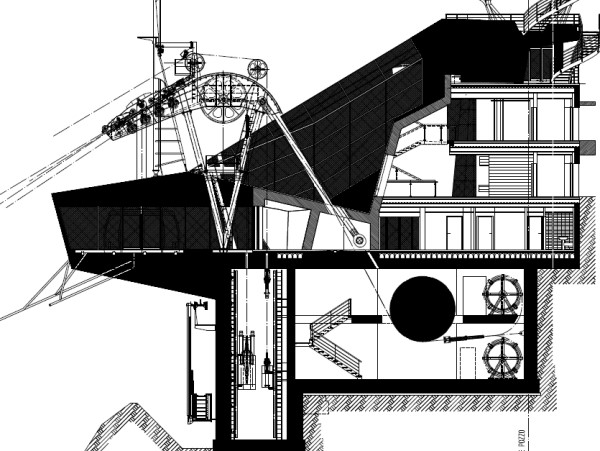
In the extremely unlikely event of being unable to return the cars to the station within a reasonable amount of time, there will be two rescue systems: an “aerial” one that allows transferring passengers from the malfunctioning car to the rescue car and the other allows lowering passengers to the ground using a “hammock”.
The aerial rescue system consits of special vehicles that move along the cables. They are moved by a special rescue cable ring spliced with its own winch that works independently from the main system, and which is located at the lower motor station and counterweighted at the upper station on two segments. The plant has a total of two rescue vehicles, one of which is located at the lower motor station and one at the drive recovery station. For the first time, even the rescue winch is double, with two engines.